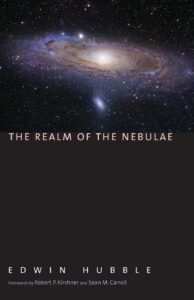 Prior to the launch of the James Webb Space Telescope that has recently delivered to us so many awe-inspiring images of the universe, it was the Hubble Space Telescope, named for astronomer Edwin Hubble and launched in 1990, that set the standard for what we could see from a space-based observational platform. Indeed, both technological developments that went into the creation of, as well as of course images from, Hubble continue to provide new information not only to astronomers and astrophysicists but to a wide range of scientists around the world.
Prior to the launch of the James Webb Space Telescope that has recently delivered to us so many awe-inspiring images of the universe, it was the Hubble Space Telescope, named for astronomer Edwin Hubble and launched in 1990, that set the standard for what we could see from a space-based observational platform. Indeed, both technological developments that went into the creation of, as well as of course images from, Hubble continue to provide new information not only to astronomers and astrophysicists but to a wide range of scientists around the world.
That this telescope was named for Dr. Hubble was indeed a great honor in recognition of his lifetime of work, particularly in extra-galactic astronomy and showing that the galaxies were not static but actually moving away from one another. However as with so many naturalists and scientists who have had their names bestowed upon technologies, ideas, or equations, too often what they themselves wrote drifts further from the direct reading experience of both specialists in their fields, who instead learn through synopses of such works, as well as the general public, who increasingly take up the opinion that all such writings are too complex for them to understand.
Regarding the later, if one looks at papers published in scientific journals, where complexity and obscurity are unfortunately now too often employed by authors in order to protect their status in a hyper-specialized sliver of the subject area at hand – to say nothing of the continuing decline in the educational system of providing would-be scientists and would-be humanities scholars a sufficient amount of general and cross-disciplinary skills to allow them to speak clearly to one another and to the wider public (pace Dr. Snow, pace) – it is understandable that the average person would think this, and they’d unfortunately be justified in doing so with many recently published books. However it wasn’t always so.
As anyone who has ever voluntarily read Charles Lyell’s Principles of Geology or Charles Darwin’s On the Origin of Species will attest, the literature of natural philosophy, natural history, and modern science can be not only intelligible to an interested general reader but also eloquent, beautiful, and enjoyable. So it is also with the public-facing writing of Dr. Hubble, the anniversary of whose birth we on this date of 20 November observe. His 1936 published book The Realm of the Nebulae is still available from Yale University Press as part of their Silliman Memorial Lectures Series that also contains the writings of such scientific worthies as Ernest Rutherford, Enrico Fermi, and Theodosius Dobzhansky. This edition also includes forewords by Sean M. Carroll and Robert Kirshner that help to place Dr. Hubble’s ideas in perspective to the time of these 1935 delivered lectures and provide explanations of what has been discovered since he committed his lectures to paper.
The fact that you are reading this essay says all that is needed to know about your interest in science, whether from days past, the present day, or both. Therefore you owe it to yourself to take advantage of such works as this one by Dr. Hubble, as well as those others mentioned here, being still in print and provided with helpful introductions to aide in your understanding of their significance and of their perhaps more obscure points, by reading them and discovering why their authors are the source of names for telescopes, theories, and similar creations that make possible our improved understanding of the world around, as well as the skies above, us.
If you enjoyed reading this, please consider signing up for The Well-read Naturalist's newsletter. You'll receive a helpful list of recently published reviews, short essays, and notes about books in your e-mail inbox once each fortnight.
